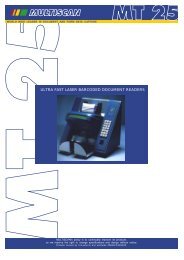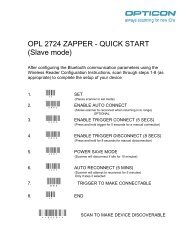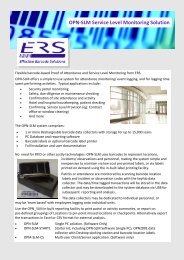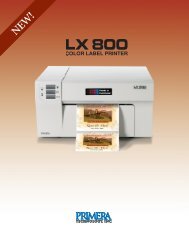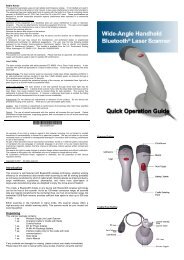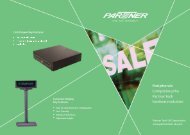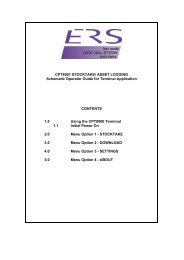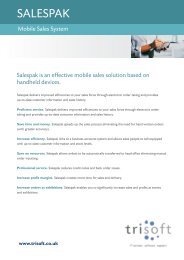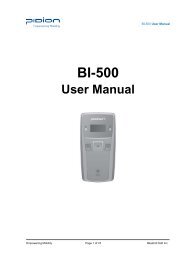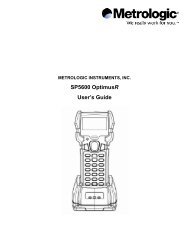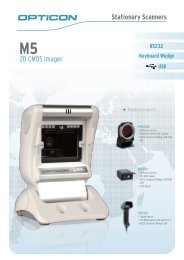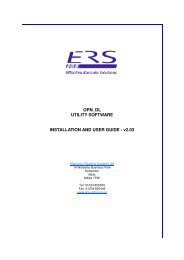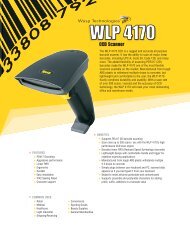User Manual - TTP243 Barcode Printer
User Manual - TTP243 Barcode Printer
User Manual - TTP243 Barcode Printer
You also want an ePaper? Increase the reach of your titles
YUMPU automatically turns print PDFs into web optimized ePapers that Google loves.
TTP/TDP 243/342<br />
THERMAL TRANSFER / DIRECT THERMAL<br />
BAR CODE PRINTER<br />
USER’ S<br />
MANUAL
CONTENTS<br />
1. PRODUCT INTRODUCTION ................................................................ 1<br />
1.1 Compliances..................................................................................................... 1<br />
1.2 Warranty Information........................................................................................ 1<br />
1.2.1 Thermal Print Head ................................................................................... 2<br />
1.2.2 Warranty Service Procedures ................................................................... 2<br />
1.2.3 General Warranty Provisions .................................................................... 2<br />
1.2.4 Limitation of Liability.................................................................................. 3<br />
2. GETTING STARTED............................................................................. 4<br />
2.1 Unpacking and Inspection ................................................................................ 4<br />
2.2 Equipment Checklist......................................................................................... 4<br />
2.3 <strong>Printer</strong> Parts...................................................................................................... 5<br />
2.4 External Label Roll Mount ................................................................................ 8<br />
2.5 Buttons and Indicators...................................................................................... 9<br />
3. SET UP................................................................................................ 10<br />
3.1 Setting Up the <strong>Printer</strong> ..................................................................................... 10<br />
3.2 Loading Label and Tag Stock......................................................................... 10<br />
3.3 Self-Peeling Function ..................................................................................... 13<br />
3.4 Ribbon Loading Instructions........................................................................... 15<br />
3.5 Install External Label Roll Mount.................................................................... 18<br />
3.6 Install Memory Module ................................................................................... 19<br />
3.7 Self Test ......................................................................................................... 20<br />
3.8 Dump Mode .................................................................................................... 21<br />
4. USING TTP-243/342 ........................................................................... 22<br />
4.1 Power-on Utilities ........................................................................................... 22<br />
4.1.1 Self Test Utility ........................................................................................ 22<br />
4.1.2 Gap Sensor Calibration Utility................................................................. 22<br />
4.1.3 <strong>Printer</strong> Initialization.................................................................................. 23<br />
4.2 Error Messages.............................................................................................. 24<br />
4.3 Troubleshooting Guide................................................................................... 25<br />
5. SPECIFICATIONS, OPTIONS, & SUPPLIES .................................... 26<br />
5.1 Specifications ................................................................................................. 26<br />
5.1.1 <strong>Printer</strong> ..................................................................................................... 26<br />
5.1.2 Indicators and Buttons............................................................................. 26<br />
5.1.3 Communication Interface......................................................................... 26<br />
5.1.4 Power Requirements............................................................................... 26<br />
5.1.5 Environment ............................................................................................ 27<br />
i
5.1.6 <strong>Printer</strong> Body............................................................................................. 27<br />
5.2 Options ........................................................................................................... 27<br />
5.3 Supplies.......................................................................................................... 28<br />
5.3.1 Label Stock.............................................................................................. 28<br />
5.3.2 Ribbon..................................................................................................... 28<br />
ii
1. PRODUCT INTRODUCTION<br />
Thank you very much for purchasing Taiwan Semiconductor TTP 243/342 bar<br />
code printer. The attractive desktop printer delivers superior performance at an<br />
economical price. Both powerful and easy-to-use, TTP 243/342 printer is your<br />
best choice among desktop direct thermal and thermal transfer label printers.<br />
TTP 243/342 printer offers both thermal transfer and direct thermal printing at<br />
selectable speeds of 1.5, 2.0 and 3.0 inches per second. It can accept a wide<br />
range of media, including roll feed, die-cut, and fan-fold labels or tags for both<br />
thermal transfer and direct thermal printing. All of the most frequently used bar<br />
code formats are available. Fonts and bar codes can be printed in any one of<br />
four directions. TTP 243/342 printer provides a choice of five different sizes of<br />
alphanumeric fonts. By using font multiplication, an even greater range of sizes<br />
is possible. Smooth fonts can be downloaded from the user friendly label desgin<br />
software. In addition, TTP 243/342 is capable of independently executing BASIC<br />
programming functions, including arithmetic, logical operation, loop, flow-control<br />
and file management, among others. This programming capability provides the<br />
greatest efficiency in label printing. The status of printer and error messages<br />
may either be printed out or viewed on a monitor by means of the RS-232<br />
connection.<br />
1.1 Compliances<br />
CE, FCC, UL, CUL, TÜV-GS, CNS<br />
1.2 Warranty Information<br />
Taiwan Semiconductor warrants to the customer that under normal use and<br />
service the bar code printer (with the exception of the print head) purchased<br />
hereunder shall be free from defects in material and workmanship for a period of<br />
one year, from the date of shipment by Taiwan Semiconductor.<br />
Expendable items or parts such as labels, ribbons are not covered by this<br />
warranty. This warranty does not cover equipment or parts which has been<br />
misused, altered, neglected, carelessly handled, or used for purposes other than<br />
those for which the printer was manufactured. This warranty also does not cover<br />
loss, damages resulting from accident, or damages resulting from unauthorized<br />
service.<br />
1
1.2.1 Thermal Print Head<br />
The warranty of the thermal print head is limited to ninety days (90) from the<br />
date of shipment to buyer. The warranty does not cover thermal print head which<br />
have been misused, altered, neglected, handled carelessly, or damaged due to<br />
improper cleaning or unauthorized repairs.<br />
1.2.2 Warranty Service Procedures<br />
If defect should occur during the warranty period, the defective unit shall be<br />
returned, freight and insurance prepaid, in the original shipping container to your<br />
purchased reseller or distributor. Include a contact name, action desired, and a<br />
detailed description of the problem and examples when possible. We shall not<br />
be responsible for any loss or damages incurred during shipping. Any warranty<br />
repairs to be performed by your purchased reseller or distributor shall be subject<br />
to said company’ s confirmation that such product meets warranty guidelines. In<br />
the event of a defect covered by its warranty.<br />
1.2.3 General Warranty Provisions<br />
Taiwan Semiconductor makes no warranty as to the design, capability, capacity,<br />
or suitability of any of its hardware, supplies or software. Software is licensed on<br />
an “ as is” basis without warranty.<br />
Except and to the extent expressly provided in this warranty and in lieu of all<br />
other warranties, expressed or implied, including, but not limited to any<br />
warranties of merchantability or fitness for a particular product.<br />
Purchaser shall be solely responsible for the selection, use, efficiency and<br />
suitability of Taiwan Semiconductor’ s products.<br />
2
1.2.4 Limitation of Liability<br />
In no event shall Taiwan Semiconductor be liable to purchaser for any indirect,<br />
special, or consequential damages or lost profits arising out of or relating to<br />
Taiwan Semiconductor’ s products, or if the performance or a breach thereof,<br />
even if Taiwan Semiconductor has been advised of the possibility thereof.<br />
Taiwan Semiconductor’ s liability, if any, to the purchaser or to the customers of<br />
purchaser hereunder shall in no event exceed the total amounts paid to Taiwan<br />
Semiconductor hereunder by the purchaser for a defective product.<br />
In no event shall Taiwan Semiconductor be liable to purchaser for any damages<br />
resulting from or related to any failure or delay of Taiwan Semiconductor in the<br />
delivery or installation of the computer hardware, supplies, or software in the<br />
performance of any services.<br />
The remedies set forth here are the sole and exclusive remedies available to any<br />
person for any damages of any kind and nature including incidental,<br />
consequential, or special, whether arising from warranty (including implied<br />
warranties), contract, negligence, tort or otherwise. In the event that any implied<br />
warranties (including but not limited to the implied warranties of merchantability<br />
and fitness for a particular purpose) are found to exist, such warranties are<br />
limited in duration to the period of the warranties.<br />
3
2. GETTING STARTED<br />
2.1 Unpacking and Inspection<br />
The printer has been specially packaged to withstand damage in the shipping<br />
process. However, for fear that unexpected damage might occur, upon receiving<br />
the bar code printer, carefully inspect the package and the device. In case of<br />
evident damage, contact the carrier directly to specify the nature and extent of<br />
the damage. Please retain the packaging materials in case you need to reship<br />
the printer.<br />
2.2 Equipment Checklist<br />
TTP 243/342 bar code printer unit<br />
One sample roll of plain label stock and wax ribbon (Not provided for E series<br />
printers)<br />
Ribbon paper core<br />
Ribbon supply/rewind spindle (2 pcs.)<br />
Label supply roll spindle<br />
External label roll mount/spindle (Not provided for E series printers)<br />
Power supply<br />
Power cord<br />
Centronics interface cable (Not provided for E series printers)<br />
Quick installation guide<br />
Windows driver<br />
Label design software<br />
Separately purchased items may also be included. These additional items may<br />
include:<br />
Label<br />
Ribbon<br />
Memory module<br />
Cutter (Unavailable on E series printers)<br />
Portable LCD keyboard<br />
If any parts are missing, please contact the Customer Service Department of<br />
your purchased reseller or distributor.<br />
4
2.3 <strong>Printer</strong> Parts<br />
Figure 1. Top front view<br />
1. Cover Release Button<br />
2. PWR., ON-LINE and ERR. Indicators<br />
3. PAUSE Button<br />
4. FEED Button<br />
5. Label Dispense Opening<br />
6. Backing Paper Opening (for use with self-peeling function)<br />
5
1. <strong>Printer</strong> Cover (in open position)<br />
2. Label Supply Roll Spindle<br />
3. Fixing Tabs<br />
4. Ribbon Mechanism<br />
5. Ribbon Supply Spindle<br />
6. Ribbon Rewind Spindle<br />
7. <strong>Printer</strong> Carriage Release Lever<br />
8. Backing Paper Opening<br />
9. Detachable Front Panel<br />
10. PAUSE Button<br />
11. PWR., ON-LINE, ERR. Indicators<br />
12. FEED Button<br />
13. Peel-Off Sensor<br />
14. Memory Module Slot (with cover on)<br />
Figure 2. Interior view<br />
6
Figure 3. Rear view<br />
1. Power On/Off Switch<br />
2. Power Supply Connector<br />
3. RS-232 DB-9 Interface Connector<br />
4. Centronics Interface Connector<br />
5. Label Insert Opening (for use with external labels)<br />
7
2.4 External Label Roll Mount<br />
Figure 4. External label roll mount<br />
8
2.5 Buttons and Indicators<br />
PWR. (POWER) Indicator<br />
The green PWR. indicator illuminates when the POWER switch is turned on.<br />
ON-LINE Indicator<br />
The green ON-LINE indicator illuminates when the printer is ready to print.<br />
When PAUSE button is pressed, the ON-LINE indicator flashes.<br />
ERR. Indicator (Error/Paper Empty)<br />
The red ERR. indicator illuminates in the event of a printer error, such as<br />
memory error, syntax error, and so forth. For a full list of error messages, please<br />
refer to section 4.2, Error Messages.<br />
PAUSE Button<br />
The PAUSE button allows the user to stop a print job and then continue the<br />
printing with a second depression of the button. By pressing the PAUSE button:<br />
(1) the printer stops printing after the printing label, (2) the PAUSE LED flashes,<br />
and (3) the printer will hold all data in memory. This allows for trouble-free<br />
replacement of label stock and thermal transfer ribbon. A second depression of<br />
the PAUSE button will restart the printer.<br />
Note: If the PAUSE button is held down for more than 3 seconds, the<br />
printer will be reset and all data of the previous printing job will be lost.<br />
FEED Button<br />
Press the FEED button to feed the label to the beginning of the next label.<br />
9
3. SET UP<br />
3.1 Setting Up the <strong>Printer</strong><br />
1. Place the printer on a flat, secure surface.<br />
2. Make sure the POWER switch is off.<br />
3. Connect the printer to the computer mainframe with the provided RS-232C or<br />
Centronics cable.<br />
4. Plug the power cord into the power supply connector at the rear of the printer,<br />
and then plug the power cord into a properly grounded receptable.<br />
3.2 Loading Label and Tag Stock<br />
1. Open the printer cover<br />
2. Disengage the printer carriage by pulling the printer carriage release lever on<br />
the left side of the platen.<br />
3. Slide the label supply roll spindle through the core of a label roll and attach<br />
the fixing tabs onto the spindle.<br />
4. Place the label roll into the label roll mount. Feed the label under the carriage<br />
and over the platen.<br />
5. Adjust the label guide to fit the width of the media.<br />
6. Engage the printer carriage.<br />
7. Wind the label roll until it becomes adequately taut.<br />
8. Close the printer cover and press the FEED button three or four times until the<br />
green ON-LINE indicator illuminates.<br />
9. When the printer is out of ribbon or media, the ON-LINE LED will not<br />
illuminate and the ERR. LED will flash. Reload the ribbon or media without<br />
turning off the printer power. Press the FEED button three or four times until<br />
the ON-LINE LED illuminates. The printing job will be resumed without data<br />
loss.<br />
10
Figure 5. Inserting label supply roll into label roll mount<br />
1. Label Supply Roll Spindle<br />
2. Label Roll Mount<br />
3. Label Roll<br />
4. Fixing Tabs<br />
11
Figure 6. Feed labels through adjustable label guide<br />
1. <strong>Printer</strong> Carriage Release Lever<br />
2. Platen<br />
3. Label Media<br />
4. Adjustable Label Guide<br />
12
3.3 Self-Peeling Function<br />
To employ the self-peeling function, load the label stock according to the<br />
following steps.<br />
1. Remove the front panel.<br />
2. Tear off the foremost one or two labels of the label stock, as befits the case.<br />
Feed the backing paper between the platen and the white “ self-peeling” roller,<br />
as shown in Figure 7.<br />
3. Feed the backing paper through the backing paper opening in the front panel,<br />
as shown in Figure 8.<br />
4 Put back the front panel.<br />
Figure 7. Setting up printer for self-peeling function<br />
1. <strong>Printer</strong> Carriage Release Lever<br />
2. Platen<br />
3. Self-Peeling Roller<br />
4. Backing Paper<br />
Note: It is recommended that the print speed be set at 2 inches (1.5 inches<br />
for TTP/TDP 342) per second when using the self peeling function of the<br />
printer.<br />
13
Figure 8. <strong>Printer</strong> ready for self-peeling function<br />
1. <strong>Printer</strong> Carriage Release Lever<br />
2. <strong>Printer</strong> Front Panel<br />
3. Backing Paper Opening<br />
4. Backing Paper<br />
5. Label<br />
Note: The E series printers are not equipped with the self-peeling device.<br />
14
3.4 Ribbon Loading Instructions<br />
1. Place an empty paper core on the ribbon rewind spindle.<br />
2. Install the ribbon on the ribbon supply spindle.<br />
3. Disengage the printer carriage.<br />
4. Pull the ribbon leader to the front from beneath the printer carriage. Attach the<br />
ribbon leader to the ribbon rewind paper core.<br />
5. Rotate the ribbon rewind roller until the ribbon leader is thoroughly, firmly<br />
encompassed by the black section of the ribbon.<br />
6. Engage the printer carriage.<br />
7. Close the printer cover and press the FEED button until the green ON-LINE<br />
LED illuminates.<br />
15
1. <strong>Printer</strong> Carriage Release Lever<br />
2. Ribbon Supply Spindle<br />
3. Ribbon Rewind Spindle<br />
4. Thermal Transfer Ribbon<br />
Figure 9. Placement of ribbon supply roll<br />
16
Figure 10. Installation of label stock and thermal transfer ribbon<br />
17
3.5 Install External Label Roll Mount<br />
Figure 11. Installation of external label roll mount<br />
1. External Label Roll Mount<br />
2. Label Supply Roll Spindle<br />
3. External Label Feed Opening<br />
4. Fixing Tabs<br />
18
3.6 Install Memory Module<br />
1. Power off the printer.<br />
2. Remove the cover.<br />
3. Insert the memory module.<br />
4. Put the cover back.<br />
5. Turn on the power<br />
1. Memory Module.<br />
2. Cover.<br />
Figure 12. Installation of memory module (Option)<br />
19
3.7 Self Test<br />
To initiate the self test mode, depresss the FEED button while turning on the<br />
printer power. The printer will calibrate the label length. If the label gap is not<br />
detected within 7", the printer stops feeding labels and the media is treated as<br />
continuous paper. In self test, a check pattern is used to check the performance<br />
of the thermal print head. Following the check pattern, the printer prints internal<br />
settings as listed below:<br />
1. <strong>Printer</strong> model and firmware version<br />
2. Mileage (E series printers without this list item)<br />
3. Flash times (E series printers without this list item)<br />
4. Check sum<br />
5. Serial port setting<br />
6. Code page setting<br />
7. Country code setting<br />
8. Print speed setting<br />
9. Print density setting<br />
10. Label size setting<br />
11. Gap (Bline) width and offset setting<br />
12. Backing paper transparence<br />
13. File list<br />
14. Memory available<br />
When the self test is completed, the printer enters the dump mode. Please turn<br />
the printer's power off and then on to resume normal printing.<br />
20
3.8 Dump Mode<br />
After the self test, the printer enters the dump mode. In this mode, any<br />
characters sent from the host computer will be printed in two columns, as shown.<br />
The characters received will be shown in the first column, and their<br />
corresponding hexadecimal values, in the second. This is often helpful to users<br />
for the verification of programming commands or debugging of printer programs.<br />
Reset the printer by turning the POWER switch off and on.<br />
21
4. USING TTP 243/342<br />
4.1 Power-on Utilities<br />
There are three power-on utilities to set up and test TTP-243/342 hardware.<br />
These utilities are activated by pressing the FEED or PAUSE button and turning<br />
on the printer power simultaneously. The utilities are listed as below:<br />
1. Self-test<br />
2. Gap sensor calibration<br />
3. <strong>Printer</strong> initialization<br />
4.1.1 Self Test Utility<br />
Install the label first. Press the FEED button and then turn on the printer power.<br />
Do not release the FEED button until the printer feeds labels. The printer<br />
performs the following items:<br />
1. Calibrate label pitch<br />
2. Print out thermal print head check pattern<br />
3. Print the internal settings<br />
4. Enter dump mode<br />
Regarding the self-test and dump mode, please refer to section 3.7 "Self Test"<br />
and section 3.8 "Dump Mode" for more information.<br />
4.1.2 Gap Sensor Calibration Utility<br />
This utility is used to calibrate the sensitivity of gap sensor. <strong>User</strong>s may have to<br />
calibrate the gap sensor for two reasons:<br />
1. The media is being changed to a new type.<br />
2. Initialize the printer.<br />
Note: The ERR. LED may flash if gap sensor is not calibrated properly.<br />
Please follow the steps below to calibrate gap sensor:<br />
1. Turn off the printer power and install blank labels (without any logo or<br />
character) on printer.<br />
2. Hold down the PAUSE button then turn on printer power.<br />
3. Release PAUSE button when the printer feeds labels. Do not turn off<br />
printer power until the printer stops and two green LEDs light on.<br />
22
4.1.3 <strong>Printer</strong> Initialization<br />
<strong>Printer</strong> initialization clears all downloaded files resident in flash memory, and<br />
sets printer parameters to default values.<br />
Parameter Default Value<br />
MILEAGE* Automatic<br />
FLASH TIMES* Automatic<br />
CHECK SUM Automatic<br />
SERIAL PORT 96,N,8,1<br />
CODE PAGE 437 (8 bit), USA (7 bit)<br />
COUNTRY CODE 001<br />
SPEED 2.0” /sec<br />
DENSITY 09<br />
SIZE 4, 2.5"<br />
GAP(BLINE) 0.12, 0<br />
TRANSPARANCY 05,05,05<br />
* Parameters not available for E series printers<br />
Please follow the steps below to initialize the printer:<br />
1. Turn off the printer power.<br />
2. Hold down the PAUSE and FEED buttons and turn on the printer power.<br />
3. Do not release the buttons until the three LEDs flash in turn.<br />
Note 1 : Printing method (thermal transfer or thermal direct printing ) will be<br />
set automatically at the activation of printer power.<br />
Note 2 : When printer initialization is done, please calibrate the gap sensor<br />
again.<br />
23
4.2 Error Messages<br />
Syntax Error<br />
Out of Range<br />
The command format is incorrect.<br />
The serial port setting is incorrect.<br />
Numeric input is too large to be processed.<br />
The input string is too long to be stored.<br />
The size of the text or bar code exceeds that of the label.<br />
Download Error<br />
The download file format is incorrect.<br />
There is not enough memory to store the file.<br />
Stack Overflow<br />
Memory Error<br />
RS-232 Error<br />
File not Found<br />
A mathematical expression is too complicated. Divide it into several expressions.<br />
The nested routine is too deep.<br />
Too many variables defined.<br />
The serial port setting is incorrect.<br />
Cannot open the file specified. Download the file again.<br />
Type Mismatch<br />
Variable type mismatch.<br />
Gap not Found<br />
Cannot detect label gap. Calibrate the label again.<br />
Clock Access Error<br />
Can not read from / write to the real time clock.<br />
24
4.3 Troubleshooting Guide<br />
The following guide lists some of the most common problems that may be<br />
encountered when operating the TTP 243/342 bar code printer. If the printer still<br />
does not function after all suggested solutions have been invoked, please<br />
contact the Customer Service Department of your purchased reseller or<br />
distributor for assistance<br />
Problem Solution<br />
Ribbon does not advance or rewind Check the setting of print method.<br />
25<br />
(SET RIBBON ON)<br />
Poor print quality Clean the thermal print head.<br />
Adjust the print density setting.<br />
Ribbon and media are not compatible.<br />
Power indicator does not illuminate Check the power cord, see whether it<br />
is properly connected.<br />
ON-LINE indicator is off Out of paper or out of ribbon<br />
Calibrate the sensitivity of gap sensor.<br />
ERR. indicator is on Command syntax is not correct.<br />
Continuous feeding when printing<br />
labels<br />
Rewind ribbon paper core is not<br />
installed.<br />
Serial port baud rate setting is not<br />
correct.<br />
Calibrate the gap sensor.
5. SPECIFICATIONS, OPTIONS, & SUPPLIES<br />
5.1 Specifications<br />
5.1.1 <strong>Printer</strong><br />
Type: Direct thermal or thermal transfer<br />
Print speed: Selectable speeds of 1.5, 2.0 or 3.0 inches per second<br />
(1.5 or 2 inches per second for TTP/TDP 342)<br />
Resolution: 203 DPI (8 dots per mm)<br />
(300 DPI, or 12 dots per mm, for TTP/TDP 342)<br />
Font styles: Five alphanumeric fonts from 0.059"H (1.5 mm) to 0.23" (6.0<br />
mm),<br />
expandable vertically and horizontally up to 8x. Smooth fonts may be<br />
downloaded from label design software<br />
Bar codes: Code 39, Code 93, Code 128 UCC, Code 128 (Subsets A, B<br />
and<br />
C), Codabar, Interleaved 2 of 5, EAN-8, EAN-13, UPC-A, UPC-E,<br />
EAN and UPC with 2 or 5 digit add-on, Postnet<br />
2D bar codes: Maxicode, PDF-417, DataMatrix<br />
Graphics: Mono PCX format<br />
5.1.2 Indicators and Buttons<br />
Indicators: PWR., ON-LINE, ERR.<br />
Buttons: POWER, PAUSE, FEED,<br />
Note:The functions of buttons and LEDs can be redefined by commands.<br />
5.1.3 Communication Interface<br />
Communications: RS-232C(DB-9) at 2400, 4800, 9600 or 19200 baud and<br />
standard Centronics interface.<br />
Character set: ANSI ASCII character set<br />
Word length: 7 or 8 data bits, 1 or 2 stop bits, even, odd or none parity.<br />
Handshaking: Xon/Xoff (on receive mode only) and DSR/DTR<br />
Input buffer: 60KB<br />
5.1.4 Power Requirements<br />
Input voltage: Switching power, 110-240 VAC, 50-60 Hz<br />
Output voltage: 24 VDC<br />
Circuit protection: 2A maximum<br />
26
5.1.5 Environment<br />
Operating temperature: 40 o F to 104 o F (5 o C to 40 o C)<br />
Storage temperature: 14 o F to 140 o F (-10 o C to 60 o C)<br />
Humidity: 10% to 95% non-condensing<br />
Ventilation: Free air movement<br />
5.1.6 <strong>Printer</strong> Body<br />
Dimensions:<br />
6.14"H x 9.13"W x 11.34"D (15.6 cm H x 23.2 cm W x 28.8 cm D); with<br />
external roll mount 17.95" D (45.6 cm D)<br />
Weight:<br />
TTP 243/342: 6.0 lbs. (2.7 kg), or 6.5 lbs. (2.9 kg) with external roll mount<br />
TDP 243/342: 5.2 lbs. (2.4 kg), or 5.8 lbs. (2.6 kg) with external roll mount<br />
5.2 Options<br />
A number of different options may be added to the TTP 243/342 bar code printer<br />
for even greater convenience and versatility. The available options include:<br />
Foreign character fonts, including Chinese, Japanese and others<br />
Expandable FLASH memory module<br />
Cutter<br />
Portable LCD keyboard<br />
27
5.3 Supplies<br />
5.3.1 Label Stock<br />
TTP-243/342 is capable of both direct thermal and thermal transfer printing.<br />
Many different direct thermal or thermal transfer stocks can be used. Refer to the<br />
following list for specifications of compatible label media.<br />
Specification<br />
Paper Width<br />
Media<br />
Label Tag<br />
Min. 1” (25.4 mm) Min. 1” (25.4 mm)<br />
Max. 4.49” (114 mm) Max. 4.49” (114 mm)<br />
Paper Weight Less than 240 g/m 2<br />
Length (Pitch) 0.4” (10 mm)¡ ª90” (2286 mm) 0.4” (10 mm) ~ 90” (2286 mm)<br />
Thickness 0.002” (0.05 mm) ~ 0.008” (0.20 mm)<br />
Max. Roll Diameter.<br />
(1” core)<br />
Inner roll diameter. Max. 4.3” (110 mm)<br />
External roll diameter. Max. 8.4” (214 mm)<br />
Roll Up Method Print surface is wound outside as standard<br />
Paper Core ID. φ25.7± 0.3 mm<br />
5.3.2 Ribbon<br />
Standard 300m by 60 or 110mm thermal transfer ribbons with wax, wax-resin, or<br />
resin coating (wound outside) are available from Taiwan Semiconductor. Of<br />
ribbon selection, it is recommended that the ribbon be at least as wide as the<br />
print media. Also, the ribbon end should be transparent.<br />
28
TAIWAN SEMICONDUCTOR CO., LTD.<br />
2F, No. 8, Alley 16, Lane 235, Pao, Chiao Rd., Hsin Tein, Taipei Hsien, Taiwan<br />
TEL: +886-2-29174145 FAX: +886-2-29159741<br />
E-mail: printer@mail2.ts.com.tw Web Site: http://www.ts.com.tw<br />
P/N: 39-0000061-10<br />
REV. B



